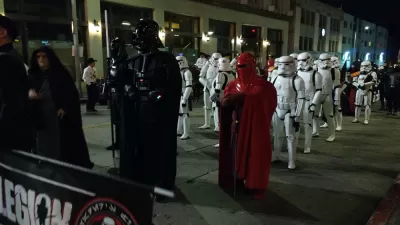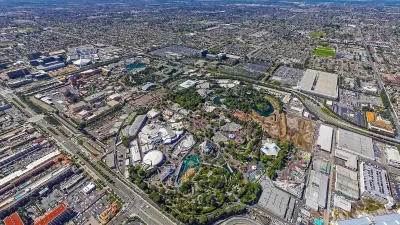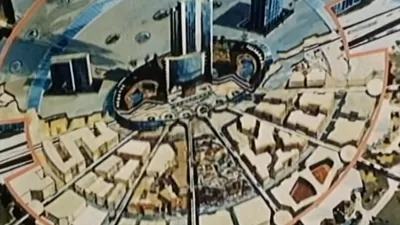Rachel James speaks with historian Jennifer Gray about the impact that Disney's "particular brand of nostalgic, comforting architecture and urbanism" has had on the way people experience the city and professionals plan for it.
"Less radical than incrementally progressive" when seen in the tradition of traveling carnivals and permanent amusement parks, Disneyland was nevertheless pioneering in its marketing and design, and particularly in its "architecture of reassurance," says Gray.
Although Disneyland's sentimental architecture is easily caricatured, Gray believes that Disney's approach to the physical and socio-political aspects of urbanism have been more profound. "Disney
amusement parks create an expectation among visitors that cities should
be immaculate, apolitical, highly ordered spaces populated, for the most
part, by people not unlike themselves."
"In recent years Disney-urbanism has colonized authentic cities," notes Gray. "Urban
entertainment districts such as South Street Seaport in New York,
Quincy Market in Baltimore, and Harbor Place in Baltimore are good
examples. South Street Seaport conveys the impression of a once-active
seafaring culture, but without the messiness of a functioning seaport –
the smell of fish, working-class dockhands, clamoring fish mongers.
Instead we find national retail and restaurant chains like The Gap and
McDonald's."
Concludes Gray, "[d]espite the fact that Disneyland is not a city but an amusement park,
Karal Ann Marling points out that it does ask the right questions: 'What
should the city look like? And who or what should be in control?'
Perhaps we just need different answers to those questions."
FULL STORY: Q&A: What Disney can teach us about urban planning

Study: Maui’s Plan to Convert Vacation Rentals to Long-Term Housing Could Cause Nearly $1 Billion Economic Loss
The plan would reduce visitor accommodation by 25,% resulting in 1,900 jobs lost.

Alabama: Trump Terminates Settlements for Black Communities Harmed By Raw Sewage
Trump deemed the landmark civil rights agreement “illegal DEI and environmental justice policy.”

North Texas Transit Leaders Tout Benefits of TOD for Growing Region
At a summit focused on transit-oriented development, policymakers discussed how North Texas’ expanded light rail system can serve as a tool for economic growth.

Virginia Law Allows Judges to Mandate Speed Limiters
The law could set a new precedent for speed limiting tech on U.S. vehicles.

Comment: EPA Cuts will Send Atlanta Back to Eye-burning Ozone, Lung-damaging Smog, and Raw Sewage in the Chattahoochee River
A veteran political journalist takes stock of the hard-earned ground Georgia stands to lose with slashed environmental protection.

How Community Science Connects People, Parks, and Biodiversity
Community science engages people of all backgrounds in documenting local biodiversity, strengthening connections to nature, and contributing to global efforts like the City Nature Challenge to build a more inclusive and resilient future.
Urban Design for Planners 1: Software Tools
This six-course series explores essential urban design concepts using open source software and equips planners with the tools they need to participate fully in the urban design process.
Planning for Universal Design
Learn the tools for implementing Universal Design in planning regulations.
City of Santa Clarita
Ascent Environmental
Institute for Housing and Urban Development Studies (IHS)
City of Grandview
Harvard GSD Executive Education
Toledo-Lucas County Plan Commissions
Salt Lake City
NYU Wagner Graduate School of Public Service





























